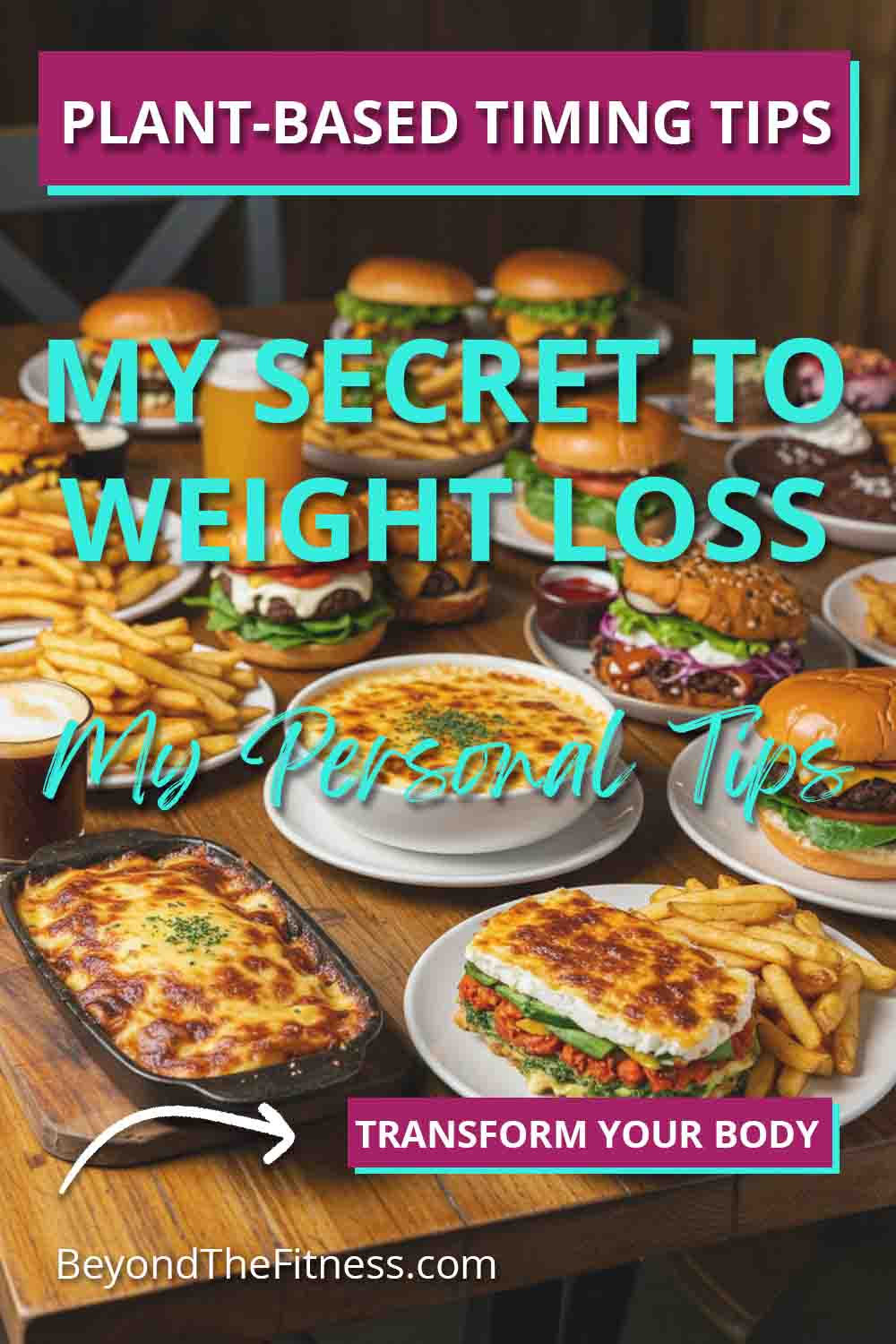Hey everyone, it’s great to connect with you again. Today, I want to talk about something super important if you’re following a vegan lifestyle and aiming for weight loss: meal timing. You might be eating all the right plant-based foods, focusing on whole grains, fruits, veggies, and legumes, which is fantastic. But when you eat those foods can make a surprising difference in reaching your weight loss goals. Think of it like fueling a car; you need the right fuel, but you also need it at the right times for the best performance. Our bodies work similarly, especially when we’re trying to shed some pounds.
As a fitness writer and weight loss consultant, I’ve worked with many women navigating the world of plant-based eating for health and weight management. One thing I consistently emphasize is that timing isn’t about rigid, stressful rules. Instead, it’s about understanding your body’s natural rhythms and working with them to optimize fat burning, energy levels, and hunger control. Let’s dive into how you can time your vegan meals effectively for maximum weight loss results.
Insider Tip: Enjoying Healthy and Flavorful Plant-Based Dishes with The Complete Plant Based Recipe Cookbook
Why Does Meal Timing Even Matter for Weight Loss?
You might wonder, “If I’m eating healthy vegan food within my calorie goals, why does timing matter?” That’s a great question. Here’s the simple scoop:
- Metabolism: Eating at regular intervals helps keep your metabolism, the engine that burns calories, running efficiently. Skipping meals or eating erratically can sometimes signal your body to slow down metabolism to conserve energy, which isn’t ideal for weight loss. Consistent timing helps maintain a steady metabolic rate.
- Energy Levels: Timing your meals right ensures you have a steady supply of energy throughout the day. Eating a balanced breakfast gives you morning power, while a well-timed lunch prevents that dreaded afternoon slump. Consistent energy helps you stay active and make better food choices later on.
- Hunger and Craving Control: Eating regularly helps manage hunger hormones like ghrelin (which makes you hungry) and leptin (which makes you feel full). When you let yourself get overly hungry, you’re more likely to overeat at your next meal or reach for less healthy, high-calorie options. Consistent meal timing helps keep hunger in check.
- Blood Sugar Stability: Spacing out your meals and snacks helps maintain stable blood sugar levels. Big spikes and crashes in blood sugar, often caused by large, infrequent meals or sugary foods, can lead to energy dips, cravings, and potentially fat storage. Plant-based diets rich in fiber are already great for blood sugar, and timing enhances this benefit.
- Digestion: Giving your body time to digest food properly between meals and especially before bed is important. Eating too close to bedtime can interfere with sleep quality and digestion. Good sleep is crucial for weight loss hormones and overall recovery.
For women, hormonal fluctuations throughout the month can also influence appetite and energy levels. Having a consistent meal timing strategy can provide a stable foundation, making it easier to navigate these changes without derailing progress.
Getting Started: Vegan Diet Basics for Weight Loss
Before we jump into timing, let’s quickly recap why a well-planned vegan diet is often successful for weight loss. Plant-based foods are typically:
- High in Fiber: Fiber keeps you feeling full and satisfied, aids digestion, and helps stabilize blood sugar.
- Lower in Calorie Density: You can often eat larger volumes of plant foods like vegetables, fruits, and legumes for fewer calories compared to processed foods or animal products.
- Rich in Nutrients: Whole plant foods provide essential vitamins, minerals, and antioxidants that support overall health and metabolism.
However, “vegan” doesn’t automatically mean “healthy” or “low-calorie.” Processed vegan snacks, desserts, and mock meats can be high in calories, sugar, and unhealthy fats. So, focusing on whole, unprocessed foods is key. Now, let’s combine this healthy foundation with smart timing.
Breakfast: Your Morning Metabolism Kickstart
I always say breakfast is like turning the ignition key for your metabolism. After fasting overnight, your body needs fuel to get going. Eating breakfast signals that energy is available, encouraging your body to start burning calories.
- Best Timing: Aim to eat breakfast within 1 to 2 hours of waking up. This helps replenish glycogen stores (your body’s readily available energy) and gets your metabolic engine humming. Waiting too long can sometimes lead to increased hunger and potential overeating later.
- What to Eat: Focus on a combination of plant-based protein, fiber-rich complex carbohydrates, and healthy fats. This trio provides sustained energy and keeps you full until lunch.
- Protein: Tofu, tempeh, plant-based protein powder (in smoothies), beans, lentils, nuts, seeds.
- Fiber/Complex Carbs: Oats, whole-grain bread or wraps, quinoa, fruits (especially berries), vegetables (yes, veggies for breakfast).
- Healthy Fats: Avocado, nuts (almonds, walnuts), seeds (chia, flax, hemp), nut butters.
- Vegan Breakfast Ideas:
- A hearty tofu scramble loaded with spinach, mushrooms, and onions, served with a slice of whole-grain toast.
- Oatmeal made with unsweetened plant milk, topped with berries, a tablespoon of chia seeds, and a sprinkle of chopped almonds.
- A smoothie blended with unsweetened almond milk, a scoop of vegan protein powder, spinach, a banana, and a tablespoon of peanut butter.
- Whole-wheat toast topped with mashed avocado, chickpeas, and a sprinkle of nutritional yeast.
Starting your day with a balanced, timely breakfast sets a positive tone for your energy and eating habits.
Lunch: The Midday Refuel
Lunch is crucial for maintaining energy levels and preventing that afternoon energy crash that can lead to reaching for sugary snacks. It keeps your metabolism active and bridges the gap between breakfast and dinner.
- Best Timing: Ideally, eat lunch about 4 to 5 hours after your breakfast. This timing typically aligns with your body’s natural dip in energy and ensures you refuel before getting overly hungry.
- What to Eat: Aim for a balanced plate similar to breakfast but often larger. Include plenty of vegetables, a good source of plant-based protein, complex carbs for sustained energy, and some healthy fats.
- Protein: Lentils, beans (black, kidney, chickpeas), edamame, tofu, tempeh, seitan (if tolerated).
- Fiber/Complex Carbs: Quinoa, brown rice, whole-wheat pasta, sweet potatoes, whole-grain bread, loads of colorful vegetables.
- Healthy Fats: Avocado, olive oil (in dressings), nuts, seeds.
- Vegan Lunch Ideas:
- A large salad packed with mixed greens, roasted vegetables, chickpeas, sunflower seeds, and a lemon-tahini dressing.
- A bowl of hearty lentil soup served with a side of whole-grain crackers or bread.
- A veggie burger (look for whole-food based patties) on a whole-wheat bun with lettuce, tomato, onion, and a side salad.
- A quinoa bowl topped with black beans, corn salsa, avocado, and steamed broccoli.
- Leftovers from a healthy vegan dinner the night before often make a perfect, easy lunch.
A satisfying, balanced lunch helps you power through the afternoon and make mindful choices for the rest of the day.
Dinner: Winding Down Smartly
Dinner is your last main meal, and timing it right is important for digestion, sleep quality, and weight management. Eating too heavy or too late can disrupt sleep and potentially lead to weight gain.
- Best Timing: Aim to eat dinner at least 2 to 3 hours before you plan to go to bed. This gives your body ample time to digest the food, preventing discomfort, indigestion, or heartburn that can interfere with sleep. Finishing dinner earlier in the evening is generally beneficial for weight loss.
- What to Eat: Dinner can be slightly lighter than lunch, especially regarding heavy carbohydrates, though this depends on your activity level and preferences. Focus on protein and plenty of vegetables.
- Protein: Baked or grilled tofu/tempeh, beans, lentils.
- Fiber/Complex Carbs: Focus on non-starchy vegetables (broccoli, cauliflower, zucchini, bell peppers, leafy greens). Include a moderate portion of complex carbs like quinoa, sweet potato, or brown rice if you feel you need it or were active.
- Healthy Fats: Use sparingly, perhaps from olive oil used in cooking or a sprinkle of seeds.
- Vegan Dinner Ideas:
- Baked tofu steaks served with a large portion of roasted Brussels sprouts and carrots.
- A flavorful black bean chili topped with a dollop of vegan sour cream or avocado.
- A large vegetable stir-fry with broccoli, snap peas, bell peppers, and mushrooms, served over a small portion of brown rice or quinoa.
- Zucchini noodles topped with lentil bolognese sauce.
- A hearty salad with grilled tempeh strips and a light vinaigrette.
Prioritizing an earlier, balanced dinner supports better sleep and allows your body to focus on repair and fat burning overnight.
Snacks: Bridging the Gaps Wisely
Snacks aren’t always necessary, but they can be helpful tools for managing hunger, maintaining energy levels between meals, and preventing overeating, especially if you have long stretches between your main meals or are very active.
- Best Timing: If needed, aim for snacks mid-morning (about 2-3 hours after breakfast) or mid-afternoon (about 2-3 hours after lunch). Listen to your body’s hunger cues. Are you truly hungry, or just bored or thirsty? Try drinking water first.
- What to Eat: Choose snacks that provide protein and/or fiber to keep you satisfied. Avoid sugary, processed options that lead to energy crashes.
- Vegan Snack Ideas:
- An apple or banana with a tablespoon of almond butter.
- A small handful of nuts (almonds, walnuts, pistachios).
- Steamed edamame (in the pod or shelled).
- A small container of unsweetened vegan yogurt with a few berries.
- Vegetable sticks (carrots, celery, bell peppers) with hummus.
- A couple of brown rice cakes with avocado.
Smart snacking keeps your energy stable and prevents extreme hunger that can sabotage your weight loss efforts.
Fueling Your Workouts: Pre- and Post-Exercise Timing
If you’re active, timing your nutrition around your workouts becomes even more important for performance, recovery, and muscle maintenance (which supports metabolism).
- Pre-Workout:
- Timing: Eat a small, easily digestible snack containing carbohydrates about 30-60 minutes before your workout. This tops off your energy stores. Avoid high-fat or high-fiber foods right before, as they can cause digestive upset.
- Examples: A small banana, a few dates, a small smoothie with fruit and plant milk, or a slice of toast.
- Post-Workout:
- Timing: Aim to consume a meal or snack containing both protein and carbohydrates within 30-60 minutes after finishing your workout. This “anabolic window” is when your muscles are most receptive to nutrients for repair and glycogen replenishment.
- Examples: A vegan protein shake, a small bowl of oatmeal with protein powder and fruit, tofu scramble with veggies, or a small meal like beans and rice.
Proper workout nutrition timing helps you get the most out of your exercise sessions and supports recovery, which is vital for consistent progress.
Don’t Forget Hydration
While we’re talking timing, let’s not forget water. Staying hydrated throughout the day is crucial for metabolism, energy, and appetite control. Sometimes thirst is mistaken for hunger. Sip water consistently between meals and snacks. Keep a water bottle handy as a constant reminder.
Listen to Your Unique Body
While these timing guidelines are helpful starting points, remember that we’re all individuals. Your ideal meal timing might vary based on your work schedule, activity level, sleep patterns, and personal preferences. Pay attention to your body’s signals.
- Are you genuinely hungry when it’s “mealtime”?
- Do you feel energized after eating?
- Are you sleeping well?
- Are you experiencing digestive issues?
Adjust the timing and composition of your meals based on how you feel and what works best for your lifestyle and weight loss journey. For women, paying attention to how your cycle affects hunger and energy can also help you fine-tune your timing.
Consistency is Your Friend
Whatever schedule you find works best, try to stick to it reasonably consistently, even on weekends. Eating at roughly the same times each day helps regulate your body’s internal clock, appetite hormones, and metabolism. This predictability makes it easier to manage hunger and make healthy choices consistently, leading to more sustainable weight loss.
You Might Be Interested In: Exploring Delicious Vegan Recipes With This Cookbook
Common Timing Pitfalls to Avoid
- Skipping Meals: Especially breakfast, can slow metabolism and lead to overeating later.
- Eating Too Late at Night: Can interfere with sleep and digestion. Aim to finish eating 2-3 hours before bed.
- Relying on Processed Vegan Foods: These often lack the fiber and nutrients of whole foods and can be calorie-dense. Stick to whole plant foods most of the time.
- Ignoring Hunger Cues: Don’t force yourself to eat if you’re not hungry, but also don’t wait until you’re ravenous. Find your balance.
By focusing on nutrient-dense whole vegan foods and pairing that with thoughtful meal timing, you create a powerful strategy for achieving your weight loss goals in a healthy, sustainable way. It’s about nourishing your body effectively throughout the day.
Related YouTube Video
Final Thoughts
So, there you have it – my perspective on timing your vegan meals for better weight loss results. Remember, it’s not about perfection but about creating a consistent rhythm that supports your body’s needs. Focusing on whole plant foods for breakfast, lunch, and dinner, timing them appropriately throughout your day, snacking wisely if needed, and fueling your workouts correctly can make a real difference. Listen to your body, be patient with yourself, and find a schedule that feels sustainable and helps you feel energized and satisfied. You’ve got this.







